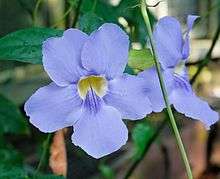Thunbergia laurifolia
| Thunbergia laurifolia Laurel clock vine | |
|---|---|
 | |
| Flowers of Thunbergia laurifolia | |
| Scientific classification | |
| Kingdom: | Plantae |
| (unranked): | Angiosperms |
| (unranked): | Eudicots |
| (unranked): | Asterids |
| Order: | Lamiales |
| Family: | Acanthaceae |
| Genus: | Thunbergia |
| Species: | T. laurifolia |
| Binomial name | |
| Thunbergia laurifolia Lindl. | |
Thunbergia laurifolia, the laurel clockvine[1] or blue trumpet vine, is native to India (Starr et al., 2003) and the Indomalaya ecozone, the species occurs from Indochina to Malaysia (Schonenberger, 1999). It is locally known as kar tuau in Malaysia and rang jeud (รางจืด) in Thailand (Chan & Lim, 2006).
Description
Thunbergia laurifolia leaves are opposite, heart-shaped with serrated leaf margin and taper to a pointed tip. Flowers are not scented and borne on pendulous inflorescences. The hermaphrodite flower is trumpet-shaped with a short broad tube, white outside and yellowish inside. The corolla is pale blue in colour with 5–7 petals, one larger than the others.
The plant flowers almost continuously throughout the year with flowers opening early in the morning and aborting in the evening of the same day. Carpenter bees are frequent visitors, creeping into the flowers for pollen and nectar while black ants are present probably as nectar scavengers. The plant develops a very tuberous root system (NRM, 2003).
Uses
Cultivation
Thunbergia laurifolia is a popular ornamental plant in tropical gardens. It is a long blooming vine in cultivation. Propagation is from stem cuttings or shoots from the tuberous roots. It is a fast-growing perennial herbaceous climber. it has become an exotic weed in many tropical countries.
Teas and Medicinal
In Malaysia, juice from crushed leaves of T. laurifolia are taken for menorrhagia, placed into the ear for deafness, and applied for poulticing cuts and boils (Burkill, 1966). In Thailand, leaves are used as an antipyretic, as well as an antidote for detoxifying poisons (Kanchanapoom et al., 2002). Several Thai herbal companies have started producing and exporting rang jeud tea (Chan & Lim, 2006). The tea has been claimed to be able to detoxify the harmful effects of drugs, alcohol and cigarettes.
Chemistry
Iridoid glucosides have been isolated from T. laurifolia (Kanchanapoom et al., 2002). Microwave-dried leaves displayed stronger antioxidant properties (AOP) than fresh leaves (Chan & Lim, 2006). AOP of infusion from microwave-dried leaves were higher than the commercial rang jeud tea from Thailand.
Invasive species
Thunbergia laurifolia can become an invasive species where escaping from ornamental garden uses into native habitats in supportive climates. Because it is a fast-growing perennial plant it has become an escaped exotic and noxious weed in many tropical countries The plant has become a weed found in the Cerrado vegetation of Brazil, and in tropical areas of Australia.
See also
| Wikimedia Commons has media related to Thunbergia laurifolia. |
| Wikispecies has information related to: Thunbergia laurifolia |
References
- ↑ "Thunbergia laurifolia". Natural Resources Conservation Service PLANTS Database. USDA. Retrieved 10 December 2015.
- Burkill, I.H. (1966). "A Dictionary of the Economic Products of the Malay Peninsula. Volume II (I–Z)". Ministry of Agriculture and Cooperatives, Kuala Lumpur.
- Chan, E.W.C., Lim, Y.Y. (2006). "Antioxidant activity of Thunbergia laurifolia tea". Journal of Tropical Forest Science 18 (2): 130–136. http://info.frim.gov.my/cfdocs/infocenter_application/jtfsonline/jtfs/v18n2/130-136.pdf.
- Kanchanapoom, T. et al. (2002). "Iridoid glucosides from Thunbergia laurifolia". Phytochemistry 60: 769–771. doi:10.1016/S0031-9422(02)00139-5.
- NRM (2003). "Thunbergia: Blue trumpet vine". Natural Resources and Mines, Queensland. http://www.nrm.qld.gov.au/pests/environmental_weeds/weed_info_series.html.
- Schonenberger, J. (1999). "Floral structure, development and diversity in Thunbergia (Acanthaceae)". Botanical Journal of the Linnean Society 130: 1–36.
- Starr, F. et al. (2003). "Thunbergia laurifolia". http://www.hear.org/starr/hiplants/reports/pdf/thunbergia_laurifolia.pdf.